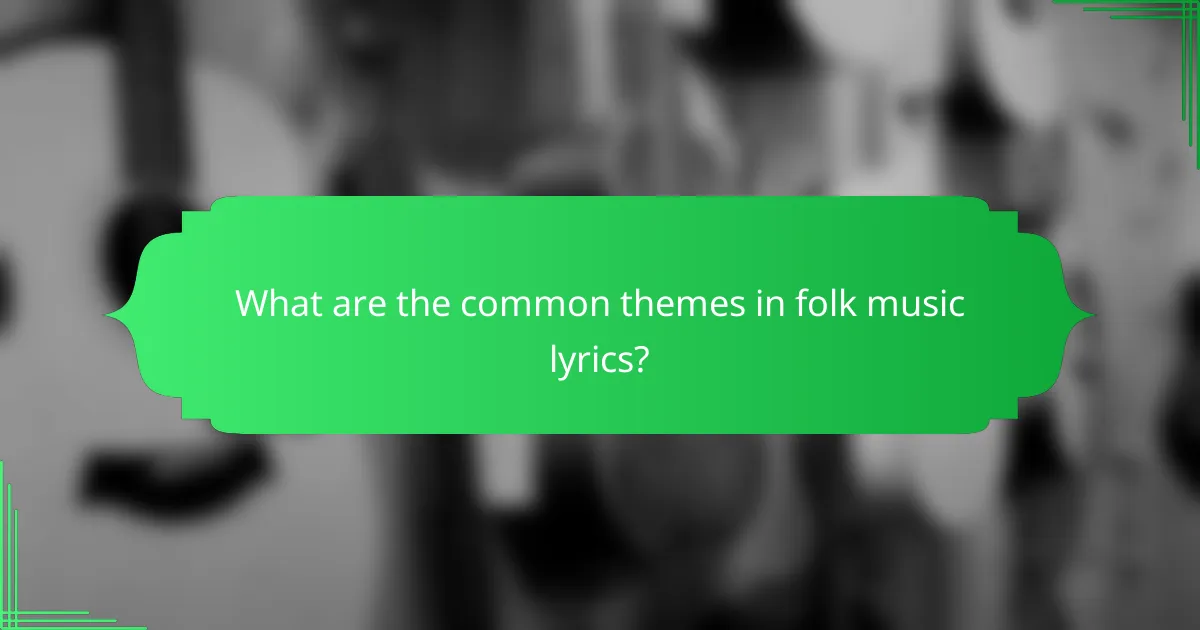Folk music is a powerful medium that embodies traditional roots and rich storytelling, often conveyed through acoustic instrumentation. This genre serves as a cultural touchstone, reflecting the experiences and narratives of communities while preserving their historical legacies. Through simple melodies and relatable lyrics, folk music connects listeners to the heart of their heritage.

How does folk music reflect Canadian culture?
Folk music serves as a vital expression of Canadian culture, showcasing the diverse stories and traditions of its people. Through storytelling and acoustic instrumentation, it connects communities and preserves historical narratives unique to Canada.
Connection to Indigenous traditions
Indigenous folk music is deeply rooted in the cultural practices of First Nations, Métis, and Inuit peoples. It often features traditional instruments like the drum and flute, and serves as a medium for storytelling, spiritual expression, and community bonding.
Many contemporary Canadian folk artists incorporate Indigenous themes and sounds into their music, fostering a greater appreciation for these rich traditions. This blending highlights the importance of Indigenous voices in the broader Canadian cultural narrative.
Influence of European settlers
European settlers brought their own musical traditions to Canada, significantly shaping the folk music landscape. Instruments such as the fiddle and accordion became staples in Canadian folk music, reflecting the diverse origins of the settlers, including British, French, and Irish influences.
These influences are evident in the melodies and lyrical themes found in Canadian folk songs, which often tell stories of hardship, love, and the beauty of the land. The fusion of these traditions has created a unique sound that resonates with many Canadians today.
Regional variations across Canada
Folk music in Canada varies widely by region, reflecting the unique cultural identities of each area. For instance, the East Coast is known for its lively sea shanties and Celtic influences, while the Prairie provinces often feature storytelling that highlights rural life and Indigenous heritage.
In British Columbia, folk music incorporates elements from both Indigenous cultures and the Asian immigrant experience, creating a rich tapestry of sounds. These regional variations not only celebrate local histories but also foster a sense of belonging among communities across Canada.

What are the key characteristics of folk music?
Folk music is characterized by its traditional roots, storytelling elements, and reliance on acoustic instrumentation. It often reflects the culture and experiences of a community, using simple melodies and relatable lyrics to convey messages and emotions.
Traditional storytelling
Traditional storytelling is a cornerstone of folk music, where songs often narrate tales of love, hardship, and historical events. These narratives serve to preserve cultural heritage and pass down wisdom through generations.
Many folk songs feature characters and scenarios that listeners can relate to, making the stories memorable and impactful. For example, ballads may recount the life of a local hero or a significant event in a community’s history.
Use of acoustic instruments
Folk music primarily utilizes acoustic instruments, which contribute to its organic sound. Common instruments include the guitar, banjo, fiddle, and mandolin, each adding a unique texture to the music.
The choice of instruments often reflects regional traditions, with specific styles and techniques that vary by culture. For instance, the use of the bouzouki is prevalent in Greek folk music, while the bodhrán is a staple in Irish folk traditions.
Community participation
Community participation is vital in folk music, as it often involves collective singing and playing. This communal aspect fosters a sense of belonging and shared identity among participants.
Events such as folk festivals, sing-alongs, and local gatherings encourage people to engage with the music actively. This interaction not only keeps the tradition alive but also allows for the evolution of the genre as new stories and styles are introduced.

Which artists are prominent in Canadian folk music?
Canadian folk music features a rich tapestry of artists known for their storytelling and acoustic instrumentation. Prominent figures include Gordon Lightfoot, Buffy Sainte-Marie, and The Tragically Hip, each contributing uniquely to the genre’s evolution and cultural significance.
Gordon Lightfoot
Gordon Lightfoot is a cornerstone of Canadian folk music, celebrated for his poetic lyrics and melodic storytelling. His songs often reflect themes of love, nature, and Canadian identity, with classics like “If You Could Read My Mind” and “The Wreck of the Edmund Fitzgerald” showcasing his narrative style.
Lightfoot’s music is characterized by its acoustic instrumentation, typically featuring guitar and piano, which enhances the emotional depth of his lyrics. His influence extends beyond Canada, as he has inspired countless artists worldwide.
Buffy Sainte-Marie
Buffy Sainte-Marie is a pioneering Indigenous artist known for her powerful voice and activism through music. Her songs often address social issues, including Indigenous rights and environmental concerns, making her a significant figure in both folk music and social justice movements.
With a unique blend of traditional and contemporary sounds, Sainte-Marie incorporates various instruments, including the dulcimer and electronic elements, into her work. Her song “Universal Soldier” remains a timeless anthem for peace and awareness.
The Tragically Hip
The Tragically Hip, often referred to as “The Hip,” is a band that has become synonymous with Canadian rock and folk music. Their lyrics frequently explore Canadian culture, history, and geography, resonating deeply with audiences across the country.
Known for their energetic performances and poetic storytelling, The Tragically Hip’s music features a mix of acoustic and electric instrumentation. Songs like “Bobcaygeon” and “Ahead by a Century” highlight their ability to capture the essence of Canadian life and identity.

What are the benefits of listening to folk music?
Listening to folk music offers numerous benefits, including cultural education, emotional connection, and support for local artists. This genre often reflects the traditions and stories of communities, making it a rich source of insight and inspiration.
Cultural education
Folk music serves as a powerful tool for cultural education, providing listeners with insights into the history, values, and traditions of different communities. Through its lyrics and melodies, folk music often tells stories that encapsulate the experiences of various cultures.
For example, songs from the Appalachian region may highlight the struggles and triumphs of rural life, while Irish folk tunes often celebrate community and heritage. Engaging with these musical narratives can deepen one’s understanding of diverse cultural backgrounds.
Emotional connection
Folk music has a unique ability to evoke strong emotional responses, often resonating with listeners on a personal level. The storytelling aspect of folk songs can mirror individual experiences, creating a sense of shared understanding and empathy.
Many folk songs address universal themes such as love, loss, and resilience, allowing listeners to connect with the music and the emotions it conveys. This emotional bond can be particularly comforting during challenging times, as folk music often provides solace and reflection.
Promotion of local artists
Listening to folk music supports local artists and musicians, helping to sustain regional music scenes. Many folk musicians rely on community support to thrive, and engaging with their work can promote the continuation of traditional music styles.
By attending local folk concerts or purchasing music from regional artists, listeners contribute to the preservation of cultural heritage. This not only enriches the local economy but also fosters a vibrant artistic community that can inspire future generations of musicians.

How can you get involved in the folk music scene?
Getting involved in the folk music scene can be both enjoyable and enriching. You can participate by attending local events, joining community groups, and supporting venues that promote folk music.
Attend local festivals
Local festivals are a fantastic way to immerse yourself in the folk music scene. These events often feature a variety of artists, food vendors, and workshops, providing a rich cultural experience. Look for festivals in your area that celebrate folk traditions, which may occur seasonally or annually.
Check local listings or community boards for upcoming festivals. Many cities host events that are free or have a low entry fee, making them accessible to everyone.
Join community music groups
Joining community music groups can enhance your connection to folk music. These groups often welcome musicians of all skill levels and provide opportunities for collaboration and learning. Look for local folk clubs or music circles that meet regularly.
Participating in these groups can lead to jam sessions, performances, and workshops, allowing you to develop your skills and meet like-minded individuals. Many groups also offer online platforms to connect with members and share resources.
Support folk music venues
Supporting folk music venues is crucial for sustaining the local music scene. Attend performances at small clubs, coffeehouses, or community centers that feature folk artists. Your attendance helps keep these venues operational and encourages them to host more events.
Consider becoming a member of venues that offer membership programs, which often provide discounts on tickets and exclusive access to events. Additionally, spreading the word about upcoming shows can help increase attendance and support for local artists.

What are the common themes in folk music lyrics?
Common themes in folk music lyrics often revolve around storytelling, cultural heritage, love, loss, and social issues. These narratives reflect the experiences and values of communities, making folk music a powerful medium for preserving traditions and conveying messages.
Storytelling in Folk Music
Storytelling is a fundamental aspect of folk music, where songs often narrate tales of historical events, personal experiences, or moral lessons. This tradition allows artists to connect with listeners on an emotional level, often evoking nostalgia or reflection.
Many folk songs feature characters and plots that resonate with shared cultural experiences. For example, songs about migration, hardship, or celebration can illustrate the struggles and triumphs of a community, making the narrative relatable and impactful.
Traditional Roots
Folk music is deeply rooted in the cultural and historical contexts of specific regions. Each locale contributes unique elements, such as language, instruments, and styles, which shape the sound and themes of the music. For instance, Appalachian folk music often incorporates elements from Scottish and Irish traditions.
These traditional roots are essential for preserving cultural identity. Artists frequently draw on historical events and local legends, ensuring that the music remains a living testament to the community’s heritage.
Acoustic Instrumentation
Acoustic instrumentation is a hallmark of folk music, emphasizing natural sounds and organic melodies. Instruments like the guitar, banjo, fiddle, and mandolin are commonly used, each contributing to the genre’s distinctive sound.
The choice of instruments often reflects the cultural background of the music. For example, the use of the lute in Eastern European folk music or the bodhrán in Irish music highlights regional characteristics, enhancing the authenticity of the storytelling.
